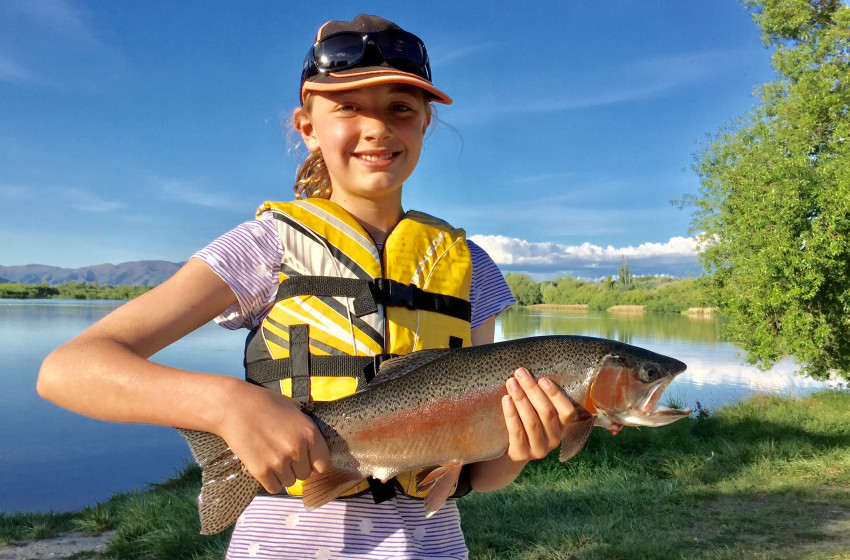Reel Life February 2019
- 26/02/2019

After a long hot summer, fresh water fishing has been given a boost with widespread rain replenishing rivers and streams and hopefully dropping water temperatures to more trout-friendly levels.
It's hoped that the higher water levels will also have flushed out the increasing volumes of algae that have plagued rivers through the recent heat wave.
While the sustained fine hot weather provided anglers with some terrific 'cicada days,' algal blooms have snagged a hook or three and sent trout in search of cooler waters.
This issue of Reel Life has some tips for both spin and fly anglers on how to get around the algae issue.
And as autumn signals its imminent arrival, there are certainly some good fish around to target.
Starting with the North Island, Hawke's Bay has reported "excellent” fish numbers in the Ngaruroro River, including record numbers of large trout noted during drift dives by Fish and Game staff and volunteers. More drift dive fish counts are planned.
Lake Rotorua stream mouths are also continuing to produce some excellent but "challenging” fishing. Staff say the warm water means trout can go off the feed for long periods.
Staff are describing the angling in the lower North Island as exceptional, with very good fish counts and "some of the best terrestrial insect hatches we've had in years.”
Down south, West Coast officers have great tips for newbies trying to catch their first trout on the coast.
In Otago, anglers have reported "amazing” cicada hatches.
In March, the river mouths of Otago's main lakes are always productive as fish congregate in preparation for their spawning migrations.
Landlocked salmon can be caught in large numbers, but remember browns and rainbows are also on the menu.
March is traditionally a good time for targeting salmon on most South Island rivers, especially with the weather cooling off.
Wherever you are fishing, how about taking a youngster along, or introducing a friend or colleague to angling? They will love it.
P.S. This month's cover pic shows Megan Hunt proudly showing off the rainbow trout she hooked on Lake Dunstan while fishing with her dad Geoff, who took the photo.
And Canadian visitor Glen Forge (right) who caught this lovely Rotorua brown trout with fishing guide Julian Danby, who snapped the photo.Thanks to Lance Black for the photo he took of seven year-old Mason Morgan (left), who caught and released this rainbow fishing at the Groynes Fishing Lakes in Christchurch.
P.P.S - If you think you've got a freshwater fishing image worthy of featuring on our 'cover', email it toRichard Cosgrovefor consideration.
Fishing News
|
'Our environment matters' |
|
|
Have your say on the future of pastoral land |
|
|
Spinning into a freshwater grave |
|
|
Eastern Fish & Game seeks angler feedback |
|
|
Get set for some game bird hunting |
Advertising Opportunity!
If you would like to advertise in the above banner position and directly reach the fishing community across New Zealand, please contact Don Rood.
Streamside with...
Will Spryrejoices in long summer days with cicadas at their peak...
Find out more
Graeme Marshall describes getting hit after hit on the Rangitata River...
Find out more
Creasy's Column - By Hugh Creasy
Hot air, thick with birch seed, blew down the valley. fishjump35Stags across the river in high-fenced paddocks, coughed and grumbled and readied themselves for the roar. There were even a few who brayed in the late evening, early starters soaked in testosterone and spoiling for a fight.
The southerly blew for days – a hot wind that kept anglers off the river until evening, when, for an hour or two, a cast could be made to fish that held in deep water. They were hard to catch. A constant hatch of small mayflies and a drift of willow grubs kept them well fed and highly selective. At night there were hatches of caddis and fish could be heard rising and splashing well after dark.
In the early morning they were sated and ignored any offering no matter how well imitated by an expert tier. As the sun rose and cast shadow under the willows it was possible to stand in the shade and cast fly after fly to fish in line astern and highly visible. Size 16 to 20 nymphs with speckled hackles were ignored...Continue reading here.
This Month's Regional News
Click on the region to read.